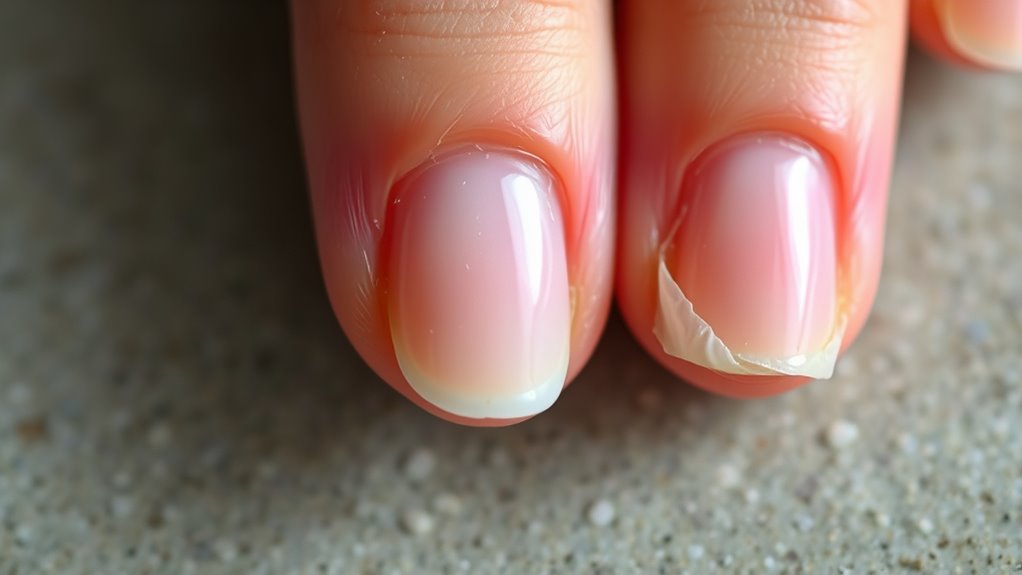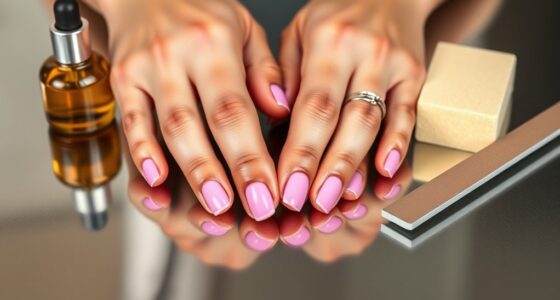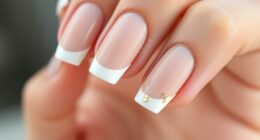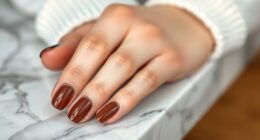Water exposure softens your nails by causing keratin to swell and weaken over time. Repeated contact, especially with hot water, increases porosity and fragility, raising the risk of cracks and splits. Frequent hand washing or swimming accelerates this damage by stripping natural oils and disrupting mineral balance. To protect your nails, it helps to use gloves, moisturize regularly, and avoid prolonged water contact. Explore ways to keep your nails healthy even in water-rich environments.
Key Takeaways
- Water absorption causes keratin to swell, weakening the nail structure and reducing overall strength.
- Prolonged water exposure softens nails, increasing the risk of breakage and cracks.
- Water interacts with the cuticle and nail matrix, impairing natural barriers and nail growth.
- Frequent immersion leads to mineral imbalance, decreasing nail resistance over time.
- Proper hydration and protective measures help maintain nail strength despite water contact.
The Science Behind Water and Nail Composition

Understanding the science behind water and nail composition is key to grasping how exposure to water affects nail strength. Nails are primarily made of keratin, a protein that contains mineral elements essential for their structure—this process is called nail mineralization. When you expose your nails to water, they absorb moisture through water absorption, causing the keratin to swell. This temporary increase in water content weakens the nail’s matrix, making it more susceptible to damage. The balance of mineralization influences how well your nails resist breaking, and excessive water absorption can disrupt this balance. Recognizing how water interacts with nail composition helps you understand why prolonged exposure can lead to softer, more fragile nails over time.
How Water Softens and Weakens Nails Over Time

When your nails spend too much time in water, the cuticle and nail matrix can weaken, leading to easier breakage. Water also causes collagen and keratin in your nails to break down, reducing their overall strength. Over time, this process makes your nails softer and more prone to damage. Additionally, frequent water exposure can hinder the natural regeneration process of your nails, further compromising their integrity. This disruption can be exacerbated by moisture imbalance, which affects the nail’s ability to recover and maintain strength. To protect your nails, it’s important to minimize prolonged water contact and consider using nail strengthening treatments to support their resilience.
Cuticle and Nail Matrix
As water repeatedly soaks into your nails, it penetrates the cuticle and reaches the nail matrix—the tissue responsible for producing new nail cells. Over time, excess moisture can compromise cuticle health, causing it to soften and become more susceptible to damage or infections. When the cuticle isn’t healthy, it can lead to gaps between the nail and cuticle, allowing water to reach the nail matrix more easily. This exposure weakens the tissue that generates your nail’s growth, making nails more prone to splitting or peeling. Continuous water contact can disrupt the nail matrix’s function, slowing growth and reducing nail strength. Additionally, understanding the self-watering mechanisms that regulate moisture can help you better care for your nails and prevent overexposure. Proper hydration balance is essential because excessive water exposure can interfere with the nails’ natural regulation of moisture, further weakening them. Maintaining good cuticle health helps protect this essential tissue, ensuring your nails grow strong and resilient despite frequent water exposure.
Collagen and Keratin Breakdown
Repeated water exposure doesn’t just weaken the cuticle and nail matrix; it also directly impacts the structural proteins that give nails their strength—collagen and keratin. Excessive nail hydration causes these proteins to break down over time, leading to collagen degradation that reduces the nail’s overall resilience. As water seeps into the nail, it weakens the keratin fibers, making nails more prone to bending, splitting, and breaking. Continuous exposure accelerates this breakdown process, compromising the nail’s natural structure. When collagen and keratin weaken, your nails lose their firmness and durability, becoming more susceptible to damage from everyday activities. Proper hydration levels are crucial, as overhydration can lead to protein breakdown, further weakening the nails. Additionally, maintaining a balanced moisture level helps prevent unnecessary damage to nail tissues. To protect your nails, limit prolonged water contact and ensure proper drying to minimize collagen degradation and preserve nail strength. Using moisturizing treatments can also help reinforce the nails’ natural barrier and resilience.
The Role of Water Temperature in Nail Damage
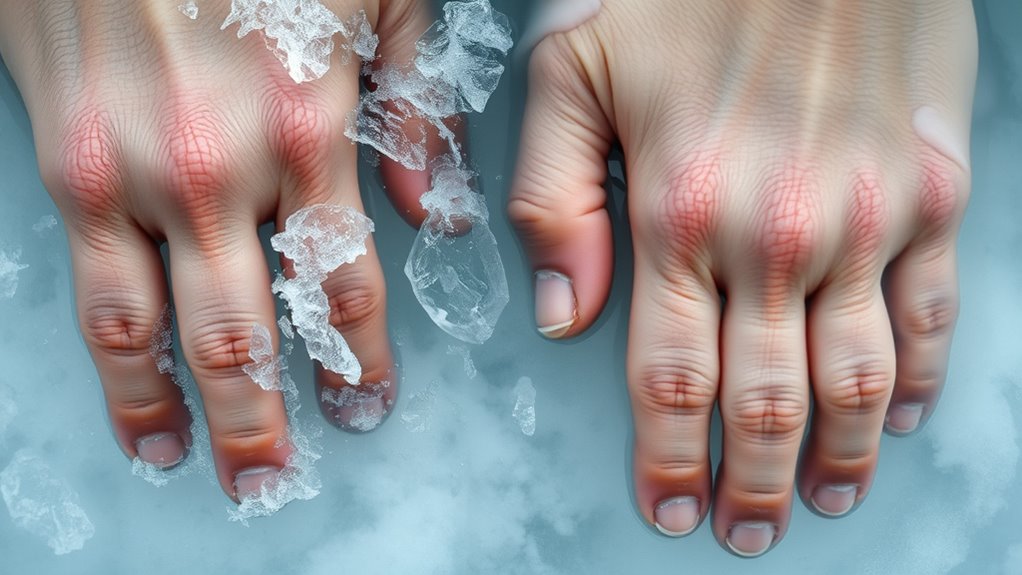
The temperature of water plays a significant role in how it affects your nails. Hot water can increase nail porosity, making your nails more susceptible to damage, while cold water minimizes this effect. When you soak your nails in hot water, it softens keratin and weakens the nail structure, leading to increased fragility. Conversely, cold water helps preserve the integrity of your nails by limiting porosity changes.
| Water Temperature | Impact on Nails |
|---|---|
| Hot (above 100°F) | Raises nail porosity, weakens |
| Warm (90-100°F) | Moderate porosity increase |
| Lukewarm (80°F) | Slight porosity change |
| Cold (below 70°F) | Preserves nail strength |
| Very Cold (ice water) | Minimal impact, best for nails |
Effects of Frequent Hand Washing on Nail Integrity
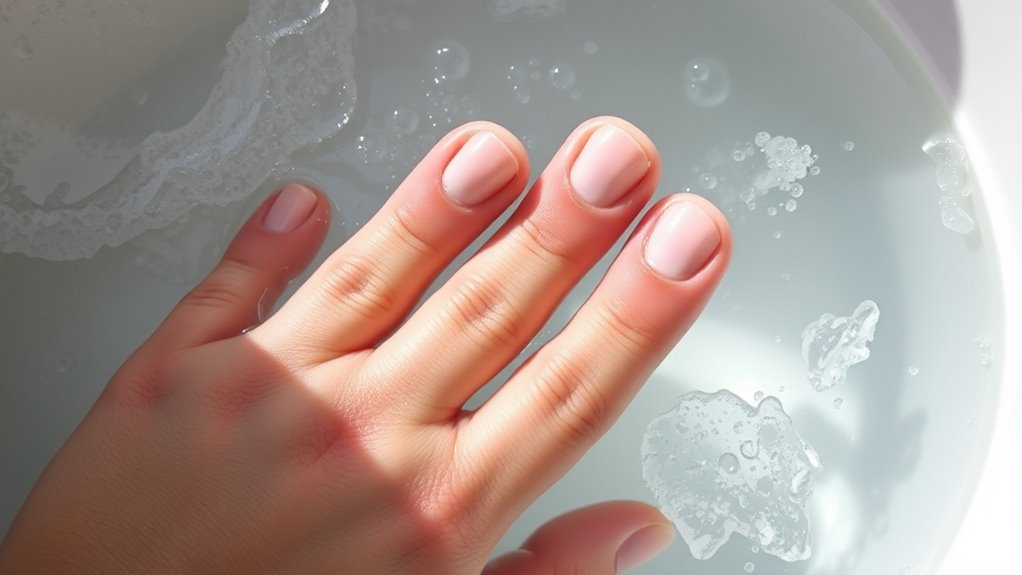
Frequent hand washing strips moisture from your nails, making them more prone to dryness and cracking. This process increases the risk of nails becoming brittle and more likely to break. Additionally, constant washing can damage your cuticles, further weakening your nail health.
Nail Moisture Loss
Because hand washing removes the natural oils from your nails and surrounding skin, it often leads to moisture loss that weakens their overall structure. When your nails lose moisture, their flexibility decreases, making them more prone to cracking and splitting. Maintaining nail hydration is essential to keep your nails strong and resilient. Frequent washing strips away the oils that help with moisture retention, leaving your nails dry and brittle. To combat this, consider applying nourishing cuticle oils or hand creams after washing. These products help lock in moisture and restore the natural balance of hydration. Proper nail moisture retention supports the integrity of your nails, preventing them from becoming overly dry and fragile over time. Additionally, understanding how water exposure impacts nail strength can help you develop better care routines. Regularly using moisture-retaining products can provide an extra layer of protection, especially in dry environments. Consistent care ensures your nails stay healthier and less susceptible to damage caused by water exposure, especially when combined with hydration strategies that promote long-term nail health.
Increased Brittleness Risks
Repeated hand washing strips away your nails’ natural oils, leaving them dry and vulnerable. This process causes nail dehydration, weakening the keratin structure and increasing brittleness indicators. As your nails become dehydrated, they lose flexibility and are more prone to cracking, splitting, or breaking. Frequent exposure to water accelerates this damage, making brittleness risks higher over time. You might notice your nails feel rough or develop tiny fissures, clear signs of increased fragility. Without proper care, these brittleness indicators can worsen, leading to more severe nail damage. To reduce these risks, consider moisturizing your nails regularly and minimizing excessive hand washing when possible. Staying aware of these brittleness signs helps you take proactive steps to maintain stronger, healthier nails despite water exposure. Additionally, AI-driven diagnostics in healthcare might someday assist in monitoring nail health more precisely. Proper nail hydration and protective measures can significantly mitigate water-related damage. Regular nail care routines and protective gloves can further lessen water’s negative effects on nail strength.
Cuticle Damage Potential
While hand washing is essential for hygiene, it can also damage your cuticles if done excessively. Repeated exposure to water strips away natural oils, reducing cuticle elasticity and making them prone to cracking or peeling. This diminishes your cuticles’ ability to protect the nail matrix, increasing the risk of infections. Additionally, frequent washing can lead to decreased nail hydration, leaving your nails more brittle and susceptible to damage. Over time, dry, compromised cuticles may hinder healthy nail growth and cause discomfort. To minimize these effects, moisturize your cuticles regularly and limit exposure to water when possible. Proper care helps maintain their elasticity and keeps your nails protected, ensuring stronger, healthier nails despite frequent hand washing. Regular Kia Tuning modifications can also improve overall nail resilience by enhancing the health of surrounding tissues. Incorporating nail care routines with nourishing oils can further support the moisture barrier and promote healthier growth. Using hydrating products specifically designed for nails can significantly boost their ability to withstand environmental stressors. Recognizing the importance of skincare habits can also contribute to maintaining optimal nail and cuticle health.
Swimming and Its Impact on Nail Health

Swimming exposes your nails to water for extended periods, which can weaken their structure over time. Constant immersion causes nails to become soft, increasing the risk of breakage. If you wear nail polish, it may chip faster due to water penetration. Regularly applying cuticle oil helps maintain flexibility and prevents dryness caused by frequent water exposure. To protect your nails during swimming, consider wearing waterproof gloves or applying a strengthening base coat before swimming. Below is a visual guide:
| Water Exposure Effect | Prevention Strategy |
|---|---|
| Nail softening | Use a strengthening base coat |
| Increased breakage | Avoid prolonged water contact |
| Nail polish chipping | Reapply or skip polish during swimming |
| Dry, cracked cuticles | Apply cuticle oil regularly |
| Weakened nail structure | Limit exposure and hydrate |
Taking these steps helps preserve your nails’ strength and health.
Household Chores and Water Exposure: Risks and Precautions
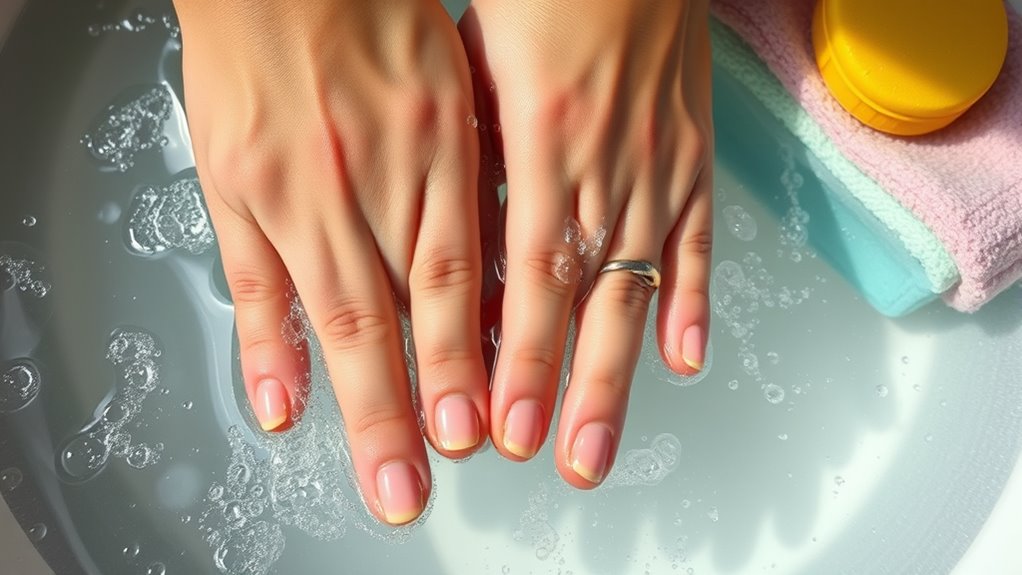
When you do household chores like washing dishes or cleaning, your nails stay in contact with water for extended periods. This exposure can weaken your nails and cause them to become brittle or break more easily. To protect your nails, consider wearing gloves and applying moisturizer after water contact.
Prolonged Water Contact Risks
Prolonged water contact during household chores can weaken your nails, making them more prone to breakage and damage. Constant exposure causes your nail polish to chip and your cuticles to become dry and cracked. Over time, this weakens the nail structure, leading to painful splits. To protect your nails, consider the emotional toll of neglecting cuticle care and the frustration of fragile nails. Here’s how water impacts you:
| Emotional Impact | Physical Effect | Practical Tip |
|---|---|---|
| Frustration over chipped polish | Increased brittleness | Wear gloves during chores |
| Anxiety about nail damage | Dry, cracked cuticles | Moisturize regularly |
| Loss of confidence | Nail breakage | Limit water exposure |
| Stress from nail pain | Weakened nail bed | Use protective base coat |
| Disappointment | Reduced nail strength | Avoid prolonged water contact |
Protective Measures for Nails
To safeguard your nails during household chores, implementing protective measures is key to minimizing water-related damage. Wearing rubber gloves creates a barrier that prevents excess water from reaching your nails, helping preserve nail hydration and moisture retention. Make sure to dry your hands thoroughly afterward, as lingering moisture can weaken nails over time. Applying a nourishing cuticle oil or moisturizer daily helps maintain nail flexibility and prevents dryness. Avoid using harsh soaps or detergents, which can strip moisture from your nails. When doing dishes or cleaning, wear gloves consistently to reduce water exposure. These simple precautions keep your nails hydrated and resilient, reducing the risk of brittleness and breakage caused by prolonged water contact. Proper protection is essential for maintaining strong, healthy nails amid household chores.
Signs of Water-Induced Nail Damage
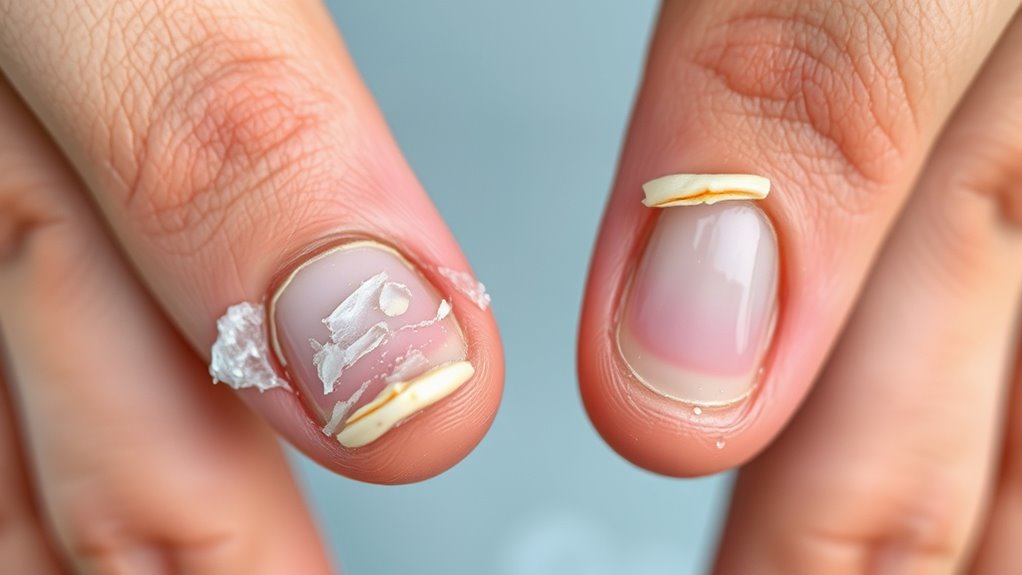
Water-induced nail damage often shows through visible changes in your nails’ appearance and texture. You might notice nail color changes, such as dullness, yellowing, or a bluish tint, indicating moisture imbalance. Additionally, you may see new or worsening nail ridging patterns, where vertical or horizontal lines develop across the nail surface. These ridges can become more prominent as water weakens the nail structure. Brittle, flaky edges or nails that peel easily are also common signs. If your nails frequently look dull or develop ridges after water exposure, it’s a clear sign that water is affecting their integrity. Recognizing these visual cues early helps you identify water damage before it worsens, allowing for timely care and protection.
Preventative Measures to Protect Nails From Water Damage

Protecting your nails from water damage starts with taking proactive steps to minimize moisture exposure. Applying a good-quality nail polish creates a protective barrier that helps prevent water from penetrating the nail surface. Make sure to reapply it regularly, especially if you frequently wash your hands or do dishes. Proper cuticle care is also essential; gently push back and moisturize your cuticles to keep them healthy and less prone to cracking or peeling when exposed to water. Wearing gloves when doing chores involving water shields your nails from prolonged moisture contact. Additionally, avoid using harsh soaps and opt for gentle hand cleansers. Staying consistent with these preventative measures helps maintain your nails’ strength and reduces the risk of water-related damage.
Strengthening Nails After Water Exposure

When nails have been exposed to water for extended periods, their structure can weaken and become more prone to cracking. To strengthen them afterward, focus on restoring nail hydration. Water absorption causes nails to swell and then become brittle once they dry out, making them more vulnerable. Applying a nourishing cuticle oil or a strengthening nail serum can help lock in moisture and support the nail’s natural barrier. Using a hydrating base coat and avoiding harsh chemicals also promotes resilience. Additionally, make certain you’re drinking enough water and maintaining a balanced diet to support overall nail health. By replenishing lost moisture and protecting against further water damage, you help your nails regain strength and reduce the risk of future cracks or splits.
Tips for Maintaining Healthy Nails in Water-Rich Environments
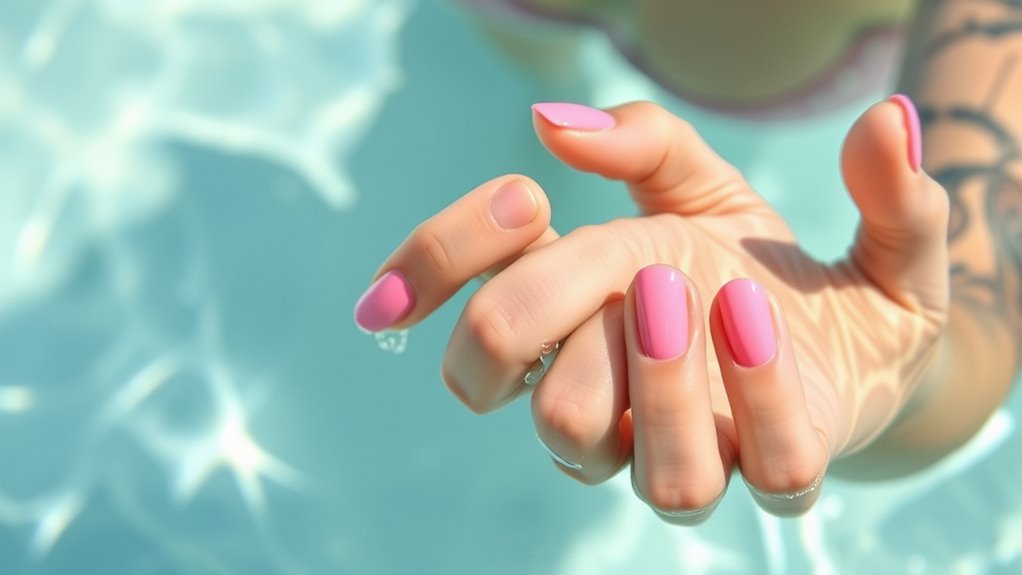
Living in water-rich environments requires extra care to keep your nails healthy and strong. To protect your nails, avoid frequent removal of nail polish, which can weaken nails over time. Use a moisturizing cuticle oil daily to nourish and prevent dryness or cracking. When exposed to water, wear gloves to reduce prolonged moisture contact that can cause nails to soften. Keep your nails trimmed and filed to prevent splitting. Incorporate a strengthening base coat to reinforce your nails and support cuticle health. Limit exposure to harsh chemicals and opt for gentle, hydrating hand lotions. Regularly massage cuticle care products to promote blood flow and overall nail resilience. These small steps help maintain the integrity of your nails, even in water-heavy environments.
Frequently Asked Questions
Can Waterproof Nail Products Fully Prevent Water Damage?
You might think waterproof nail products fully prevent water damage, but waterproofing myths often lead to overconfidence. While these products do provide a barrier, nail product limitations mean they can’t make nails completely waterproof. Water can seep in through tiny gaps or when the coating wears off, especially with frequent exposure. So, don’t rely solely on waterproof products; give your nails breaks and keep them dry to maintain strength.
Does Wearing Gloves Eliminate All Risks of Water Exposure to Nails?
Wearing gloves substantially reduces water penetration, but it doesn’t eliminate all risks of water exposure to your nails. Glove efficacy varies depending on the material; latex gloves offer better protection than cloth ones. However, even high-quality gloves can develop tiny tears or holes over time, allowing water to seep through. So, while gloves minimize water contact, they don’t completely prevent water exposure, and your nails can still be affected.
How Long Does It Take for Water Damage to Appear on Nails?
Water damage can appear quickly, often within a few hours, especially if your nails have high porosity. When water penetrates the nail, it causes swelling and softening, weakening the structure. You might notice peeling, splitting, or discoloration as signs of water damage. To prevent this, limit water exposure and consider using protective barriers like gloves, especially if your nails are more porous or prone to damage.
Are There Specific Nail Treatments That Resist Water Weakening?
You’ll find that certain nail strengthening and water-resistant treatments can help protect your nails from water damage. Look for products with keratin or biotin, which fortify nails, and choose water-resistant topcoats to create a barrier. Regularly applying these treatments can reduce water penetration, keeping your nails stronger and less prone to weakening. Incorporating these into your nail care routine assures your nails stay healthy despite frequent water exposure.
Can Diet Influence Nail Resilience Against Water-Induced Damage?
Ever wondered if your diet could shield your nails from water damage? Nutritional factors play a vital role in nail resilience, impacting their ability to withstand moisture. A diet rich in biotin, zinc, and protein boosts nail strength and flexibility, making them less prone to weakening from water exposure. By nourishing your body with these nutrients, you actively enhance your nails’ defenses, keeping them healthier and more resistant to damage.
Conclusion
So, next time you plunge into water without a care, remember: your nails might just thank you with a slow, soggy surrender. But don’t worry—ignoring water damage is the true secret to resilient nails. After all, who needs strength when you can have beautifully brittle tips, right? Keep neglecting those tiny warriors, and they’ll happily surrender, proving that sometimes, the best way to keep nails strong is to ignore them entirely. Cheers to soggy, fragile fingertips!
